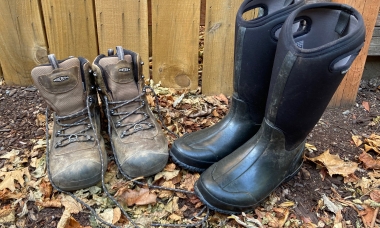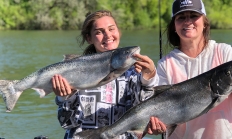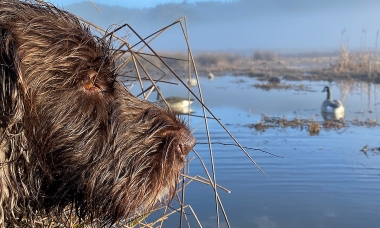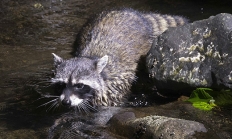
Search myodfw.com
Features: Gaper clams have large "neck" housing the two siphons that protrude above the substrate surface when feeding. Protective leathery plates are found just below the siphon tips and feel rough to the touch. Gapers are unable to retract their neck entirely into the shell, producing a "gape" in the shell. It is common for algae to grow on their necks and gaper pea crabs to dwell inside the shell with the gaper clam. Habitat: Gapers can be found in high salinity sandy and/or muddy areas in most of Oregon's larger estuaries. Tillamook, Netarts, Yaquina, and Coos are favorite bays

Nick Myatt, Region Manager Golden eagle research in northeast District wildlife staff in Wallowa County, in partnership with the U.S. Fish and Wildlife Service and the Nature Conservancy, began a pilot project to study the survival, movement, and reproductive success of golden eagles. During the pilot phase, ODFW staff tested methods of capture as well as telemetry units to determine feasibility for a longer-term study. The first capture event during this pilot project took place in mid-December 2024. USFWS provided four GPS units for this pilot year. The data from golden eagles captured in northeast Oregon during this pilot phase

Not sure what to do with a fishing rod even if you had one? Thought about hunting but getting started seems like an impossible task? Then let us help you. During ODFW's hands-on workshops and family fishing events we will provide the instruction and gear you'll need to actually catch a fish or shoot a pheasant. Other classes will help you navigate the controlled hunt process, or show you what equipment you'll need to hunt or fish.

It’s hard to enjoy a day of hunting if your feet are cramped, wet or cold. Many turkey hunters in Oregon have at least two different pairs of boots to meet the variety of conditions they might encounter while hunting. Rubber boot for cold, wet conditions Rubber knee boots are a good choice when conditions are cold and wet, and/or when you’ll be sitting for hours in a ground blind. Many boots are insulated to help keep your feet warm. If you’re looking at uninsulated boots, buy them ½ to one size larger than you normally wear. This will give


Not sure what to do with a fishing rod even if you had one? Thought about hunting but getting started seems like an impossible task? Then let us help you. During ODFW's hands-on workshops and family fishing events we will provide the instruction and gear you'll need to actually catch a fish or shoot a pheasant. Other classes will help you navigate the controlled hunt process, or show you what equipment you'll need to hunt or fish. ODFW offers many classes and workshops throughout the year. View and register for an upcoming event in our new Volunteer and Event Management

The common raccoon is a moderately sized, heavily furred mammal best characterized by its distinctive markings. The face has a dark brownish-black eye mask sharply separated from whitish nose patches, eyebrow lines, and exclamation points between the eyes. The inside of the ears is ringed with white, adding to the facial contrast. The tail is annulated with five to seven dark rings separated by light gray or tan rings. The hind legs are longer than the front; thus, in a walking gait, the rump is higher than the head. The common raccoon occurs in suitable habitats throughout Oregon; it does


Turkey behavior changes over a hunting season. So it helps to think a bit like a turkey when planning your strategy for finding turkeys and setting up your hunt. Spring turkey behavior By the time hunting season opens on April 15, most of the hen turkeys have already bred. Though they may not be sitting on their nests quite yet. This keeps tom turkeys close to the hens during the first few weeks of the season, making it difficult for hunters to lure toms away from hens and into shooting range. If tom numbers are low, they are less likely

Free fishing weekend June 7-8 in Oregon, family-friendly fishing events held statewide
SALEM, Ore.—Everyone can fish, clam and crab for free in Oregon on Saturday and Sunday, June 7-8, 2025. No fishing/shellfish licenses or tags (including a Combined Angling Tag or Columbia River Basin Endorsement or Two-Rod Validation) are required on these days. Both Oregon residents and…
MARINE FISHING December 4, 2025 Announcements Starting Jan. 1, 2026, an Ocean Endorsement is needed for most recreational anglers fishing in the ocean. Check the Ocean Endorsement page for more information. Saltwater News Bulletins Be among the first to know about in-season changes! You can subscribe to receive emails and text message alerts for marine topics that interest you. It's easy to unsubscribe at any time. Your contact information will remain confidential. Three different lists of interest to ocean enthusiasts are available: bottomfish, halibut and ocean salmon. Bottomfish A few reminders 2026 season dates and bag limits will be adopted

ODFW hosts July 29 public meeting on 2026 sport Pacific halibut season
NEWPORT, Ore. – The Oregon Department of Fish and Wildlife is hosting a public meeting on July 29 from 6 p.m. – 7:30 p.m. to get input on the 2026 recreational Pacific halibut season. The meeting is being held in the conference room of the ODFW office, 2040 SE Marine Science Dr. in Newport with a…

Upon taking an adult salmon, steelhead, legal-size sturgeon or Pacific halibut, the angler must immediately enter the codes for the species caught, ocean port or stream, and the month and day of catch. The information from these tags helps ODFW manage the fisheries and estimate total harvest. Currently nearly 40 percent of anglers use e-tagging. Want to switch from paper to electronic? Login to your account and look under your profile to switch.

Wild fall Chinook harvest to reopen in the Snake River beginning Oct. 4
ENTERPRISE, Ore. – ODFW, in coordination with co-managers, will reopen harvest of wild (adipose-intact) fall Chinook salmon in the Snake River effective Saturday, Oct. 4. The reopening follows a temporary closure implemented in September to ensure fisheries remained within agreed harvest limits…
Trout fishing opportunities abound in this zone, known for its high desert climate, sage-covered canyons, glacial peaks and mountain lakes. Anglers will find year-round trout fishing in the Deschutes, Metolius, Fall and Crooked rivers, while several central Oregon lakes and reservoirs are renowned for their trout and kokanee fishing – and their beauty. The Hood and lower Deschutes – both tributaries of the Columbia River – offer high desert fishing for Chinook salmon and summer steelhead.
The granite peaks of Oregon’s Blue and Wallowa Mountains form the backdrop for many of this zone’s glacier-carved lakes and crystalline streams. Bull trout thrive in this zone’s cold, clear rivers, which also sustain whitefish and rainbow trout, and welcome returning runs of hatchery-reared steelhead. Chinook salmon travel over 300 miles up the Columbia to spawn in rivers such as the Imnaha and Wallowa. Warmwater fisheries are few, but the John Day River offers world-class fishing for smallmouth bass.
A dozen great rivers pour out of the Coast Range Mountains into tidal bays that welcome runs of salmon and steelhead. Bays are the year-round home to marine perch, rock fish, crabs and clams, while other species come and go with the seasons and tides. A handful of ponds dot the forested slopes, and there are dozens of dune lakes— many stocked with rainbow trout, and some harboring largemouth bass, perch, crappie and brown bullhead.
